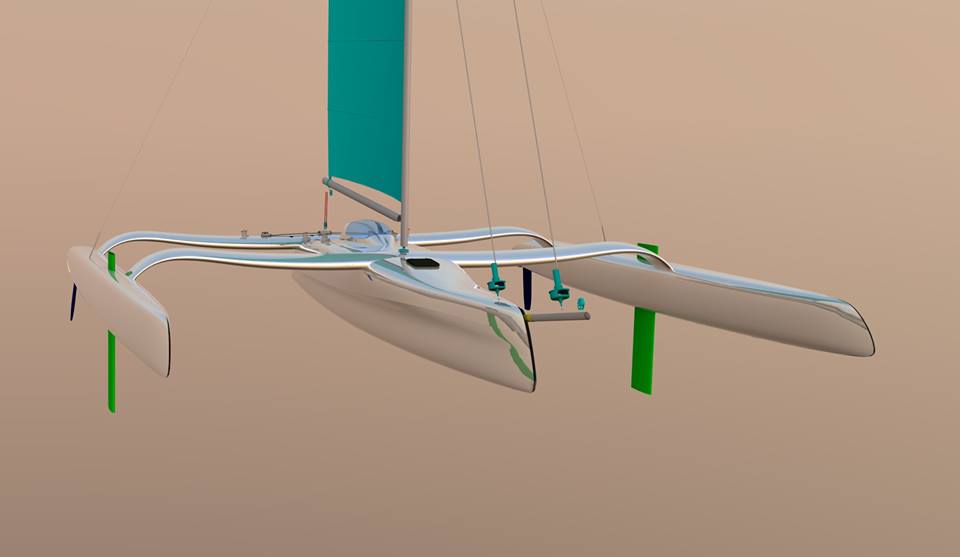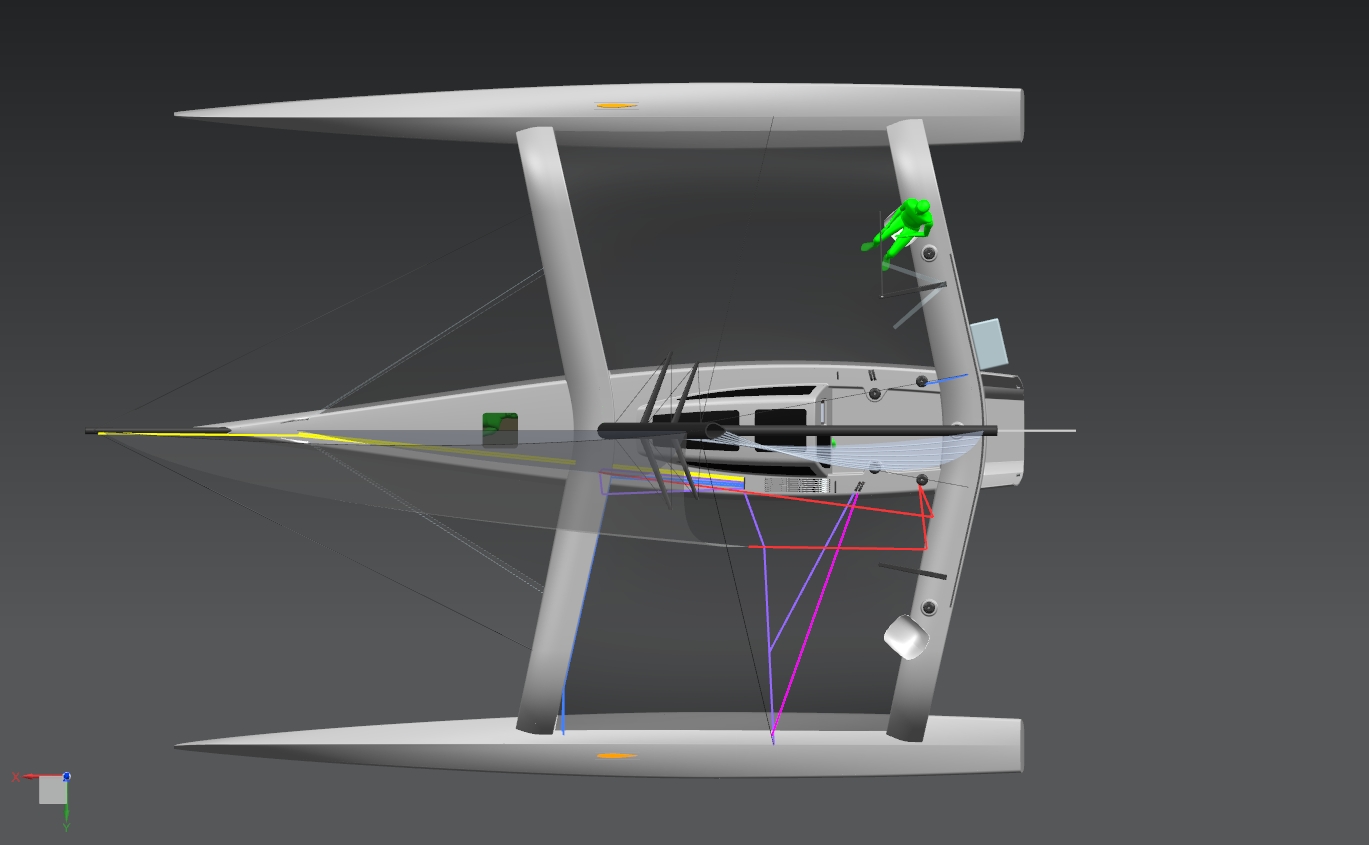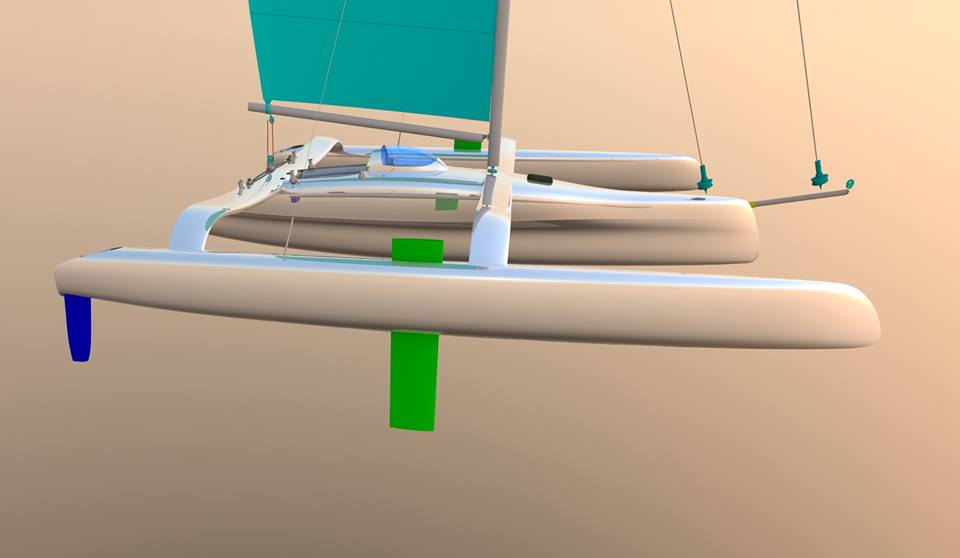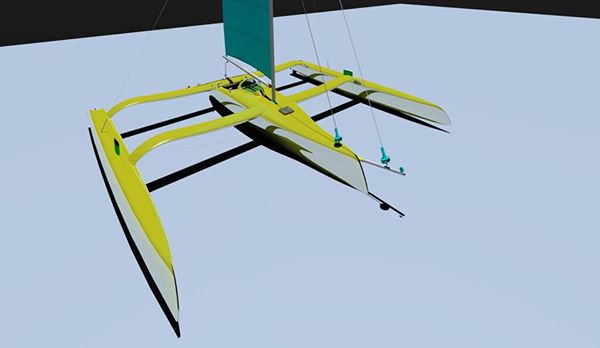One of the guys from Steamradio just had a 40’ performance trimaran designed by Shuttleworth. I was surprised how much it resembled a study that I did for Phil Steggall a few years ago. It didn’t get built and I forgot about it. It is almost the same sailor use program. And it was based on improvements to my 40’ tri, the Geko. The Geko was optimized for singlehanding and light weather. The two trimarans above are for more wind than Geko usually found.
The beams are not swept forward on Phil’s boat. I asked multihull engineer and composites god Ronnal Reichard about that. He declared it an inefficient idea as it introduces an added twisting moment to the main beams. He dismissed the advantages of helping the ama bow as the ama has much more section property to work with, to ease that stress. The tri had square L/B design of course.
It has been suggested that swept forward beams keep the weight of the beams forward. The vast majority of the bending load, and thus the laminate, is near the middle and aft.
The biggest improvement to the Geko would have been adding the flare to the main hull. Any crew or guests need to toss their bags and foulies somewhere, out of the middle. I forgot about that. I thought everything else worked pretty well, for a shorthanding fast 40’ tri.
Boards in the amas solves the board intrusion in the main hull, but if short tacking, one needs a crew or it is more difficult to tack smartly. I wanted smart tacks on the Geko. Not everybody has to short tack all day in light weather.
Where to helm from is an interesting exercise. And I found that it is most dependant on the crew or lack of. Reflexively, everybody should be up on the high side. These boats typically have almost deck sweeping mains, and are doing twice the speed of anything else out there. Anything could be happening behind that main. I always ended up in the cockpit, down low, so that I could see traffic approaching from the low side, helm in one hand, and mainsheet in the other.
 With a crew, that is not a problem, but where to steer from depends on how much the helm (owner usually?) trusts the mainsheet trimmer. I pretty much only trust myself when it’s gusty, unless Dave Calvert is crewing….
With a crew, that is not a problem, but where to steer from depends on how much the helm (owner usually?) trusts the mainsheet trimmer. I pretty much only trust myself when it’s gusty, unless Dave Calvert is crewing….
Is that a pair of main winches I see on the top view on the back beam? That suggests it’s optimized for at least double handing or a crew then. Double handing I was told.

the Shuttleworth tri
It’s all very interesting, imagining how design affects life blasting upwind. And the interesting ways that a design can be fitted to the owner’s individual needs.


I am interested in trimarans of about 40 feet, si i would like to know if you have some pictures (or a plan study) showing the interior layout of your 40 trimaran ?
Thank you in advance.
working on that one right now. keep in contact
The tri just below the heading looks a lot like a simpler design the Gougeons drew up for that client. It had three wave piercing Stressform hulls. The idea was minimal resistance, minimal loads and rig. It was for the Ostar, and maybe the hope was for it to slide on through the power fleet like Cheers.
minimal resistance good. everything else is different.
I would like to build 26′ – 28′ with a shape like this. The question is that at 40′ here, could its sleek lines translate to what would be a fatter and shorter design in the 26-28′ range and still have enough interior volume? What I like about your brilliant 26′ CM trimaran design is the excellent interior space and ease of construction. For me the 27′ for Simmo lacks the flow and beauty of this 40′ and the appeal of the 26′ in CM. I love what you have done with this functional organic and flowing shape. To model like that! Second best: build one of your amazing trimarans. To put that much work in, I feel one has to absolutely make the commitment to beauty. I have never seen anything like this and I wonder if a smaller version fits within the scope of what I am working on for the 26′ CM trimaran as a project.
All I can say, Kurt, is that study you did is for a gorgeous boat.
The arms on Girlfriend are curved in order to form the cockpit area and since one mold was used for both arms the forward arm is curved as well. Fred Courouble and Herve Devaux didn’t mention structural disadvantages to the curve and in fact thought curvature helped with torsional stiffness but they did see issues with fabrication. We used a stringer/strongback mold for the “structural plate” element that had over 100 layers in sections and CNC foam mold for curved “fairing” element that had much less laminate.
I’ve always wondered about using a couple of closed circuit cameras on the front of each float and either wearing a visor or having a monitor on the outer helming stations. Good quality systems are inexpensive now and lightweight. Maybe it’s just a geeky idea and keeping things simple is better 🙂
on the front swept beams: Look like its a function of the mast far aft – then the mainsail traveller is also far aft – and you want a curved traveller – specially in the mid section. Then the amas is going forward – more than the main bow – then the swept beams make sense and looks good too. It will also give more space to place the ama-boards – that maybe could be lifting boards in the future?
What is considered the main difference between designed for single handed verses double handed apart from requirement for good autopilot
How much would approx cost to design 40foot tri performance tri on my requirements
Ball park cost of construction for it?
Hi Kurt, what CAD system do you use? cheers Peter s
Microstation, Rhino, and Generic(still)